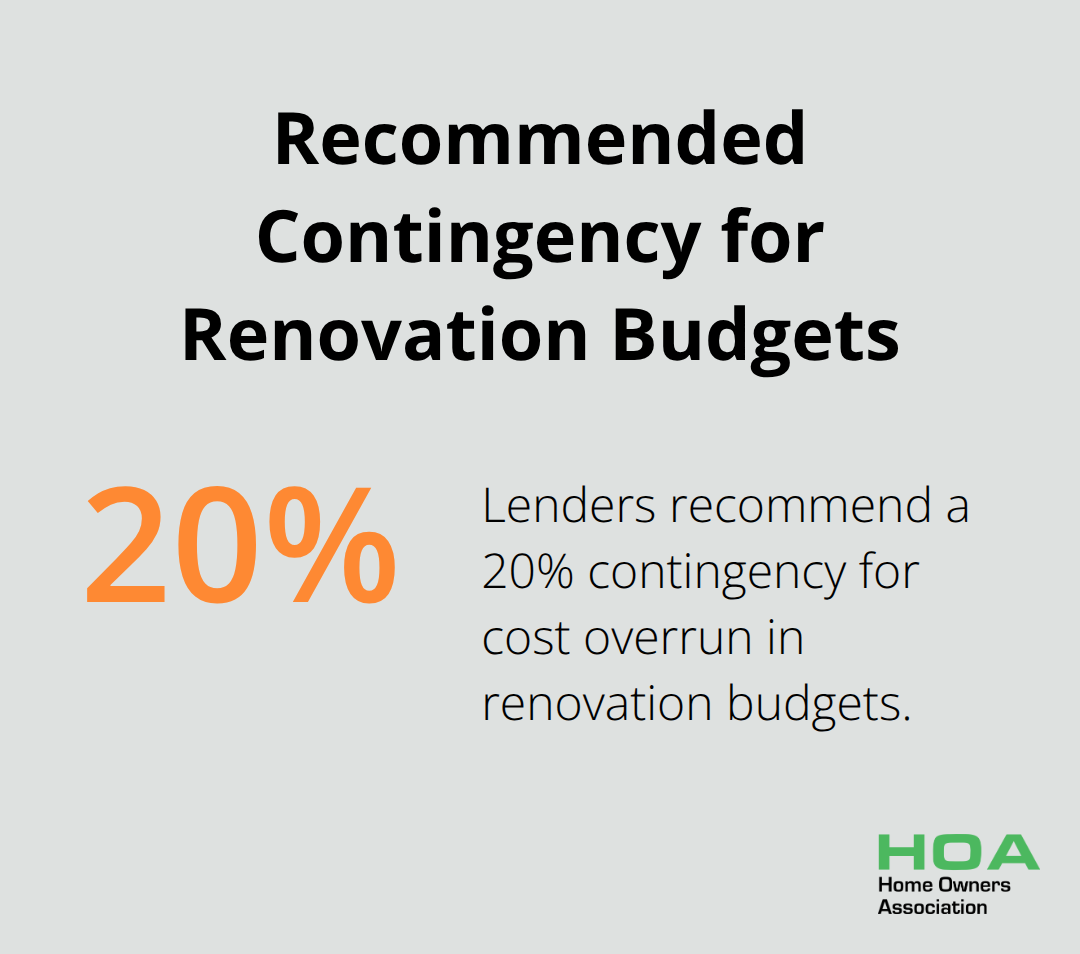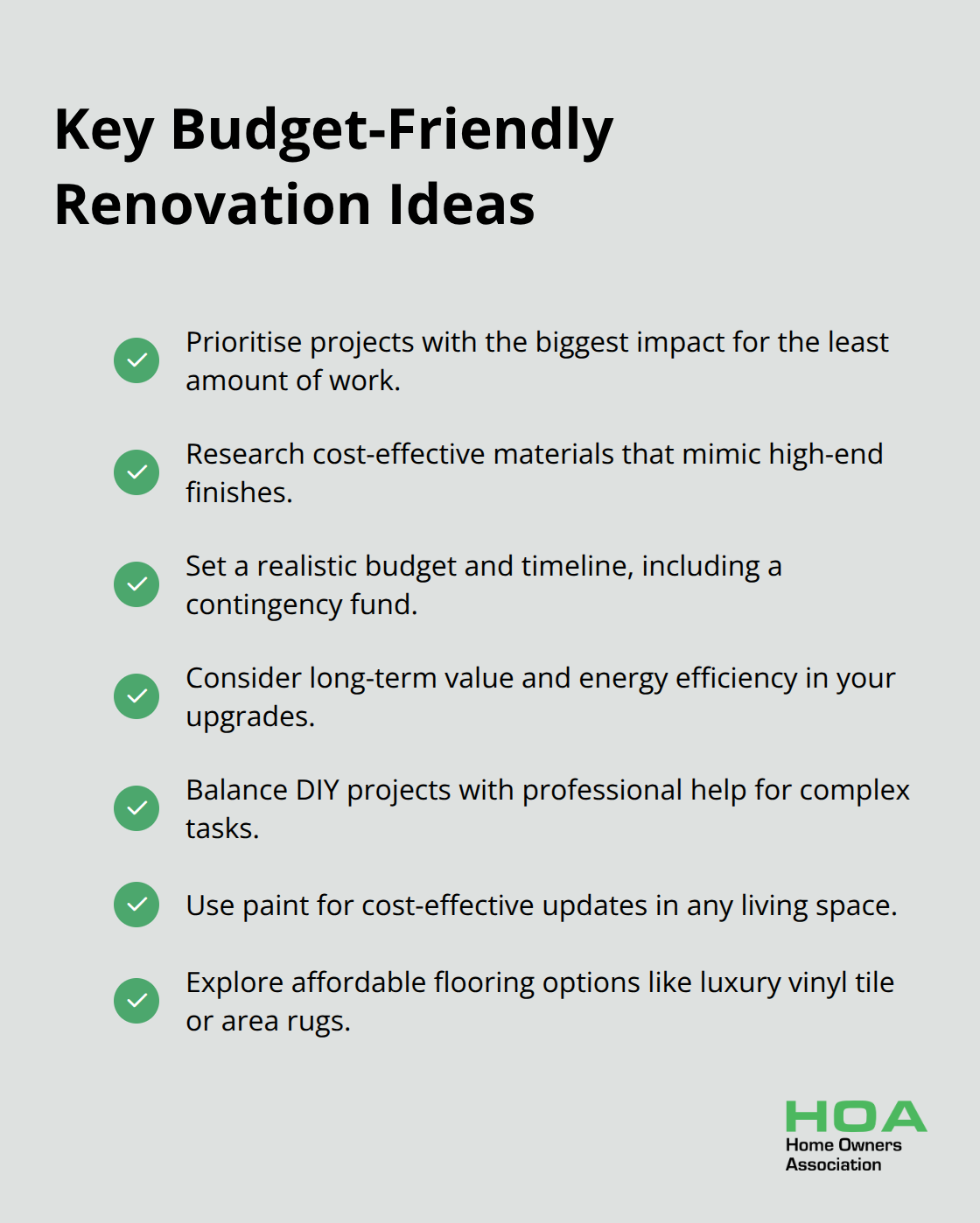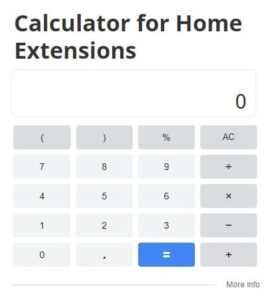
At Home Owners Association, we understand the desire to refresh your living space without breaking the bank. Renovating on a budget is not only possible but can be incredibly rewarding.
This guide will walk you through some of the cheapest renovation ideas that can transform your home without emptying your wallet. From smart planning to DIY tricks, we’ll show you how to make the most of your renovation budget.
How to Plan a Budget-Friendly Renovation
Prioritise Your Projects
Start by listing all the changes you want in your home. Rank these projects based on their importance and potential impact. Focus on the ones that will make the biggest impact for the least amount of work. Updating an outdated kitchen or bathroom often yields a higher return on investment compared to cosmetic changes in less-used spaces.
Research Cost-Effective Materials
After you prioritise your projects, explore affordable materials. Look for alternatives that mimic high-end finishes at a fraction of the cost. Luxury vinyl plank flooring can give you the look of hardwood without the hefty price tag. Many homeowners find great deals on materials through trade pricing and discounts (which can lead to substantial savings).
Set a Realistic Budget and Timeline
Create a detailed budget for each project, including materials, labour, and a contingency fund. Many lenders recommend including a 20% contingency right off the bat for cost overrun.

Be realistic about how long each project will take. Rushing can lead to costly mistakes. If you plan to do the work yourself, factor in the time it will take to learn new skills or techniques.
Leverage Your Resources
Take advantage of the resources available to you. Expert advice and educational materials can guide you through your renovation journey. Don’t hesitate to consult with professionals for complex tasks like electrical work or plumbing to ensure safety and compliance with local building codes.
Consider Long-Term Value
When planning your renovation, think beyond immediate aesthetics. Consider upgrades that will add long-term value to your home. Energy-efficient appliances, for example, might cost more upfront but can save you money on utility bills over time. Similarly, quality materials in high-traffic areas can reduce future maintenance costs.
Now that you have a solid plan for your budget-friendly renovation, it’s time to consider which tasks you can handle yourself and when it’s best to call in the professionals. Let’s explore the balance between DIY projects and professional help in the next section.
DIY or Pro: Making the Right Choice
Evaluate Your Skills
Before you start your renovation project, take an honest look at your abilities and available time. Many homeowners can handle tasks like painting, installing new hardware, or laying vinyl flooring. These projects can save you money without compromising quality. Make sure you can commit the necessary time before you begin.
Professional Expertise Matters
Some jobs require expert knowledge. Always leave electrical work, plumbing, and structural changes to licensed contractors. This approach ensures safety and compliance with local building codes. The Australian Building Codes Board warns that non-compliant work can result in hefty fines and even affect your home insurance.
Find Reliable Contractors
If you need professional help, don’t automatically choose the cheapest option. Look for licensed contractors with positive reviews and request detailed quotes. Many homeowners find success through vetted professional networks (often securing better rates through partnerships).
Hidden Costs of DIY
While DIY can reduce expenses, it’s not always the most cost-effective choice. Tools, materials, and potential mistakes can add up. A study by ImproveNet revealed that 63% have regretted at least one of their DIY projects. Always factor in these potential expenses when you decide between DIY and hiring a pro.
Quality vs. Cost
The goal is not just to save money but to add value to your home. Sometimes, professional work for key areas like kitchens and bathrooms can yield a better return on investment. The National Association of Realtors reports that kitchen remodels can recover up to 59% of their cost at resale, which makes them worth considering for professional execution.
A careful assessment of your skills against the complexity of each task will help you create a renovation plan that combines cost-saving DIY work with strategic professional interventions. This strategy ensures you get the most value out of your renovation budget while achieving high-quality results. Now, let’s explore specific cost-cutting strategies for major renovation areas in your home.
Smart Savings for Kitchen, Bath, and Living Areas
We at Home Owners Association have compiled effective strategies to update your space without overspending. Let’s explore budget-friendly options for key areas of your home.
Kitchen Makeovers on a Budget
Kitchens often consume a large portion of renovation budgets, but affordable refreshes are possible. Instead of full cabinet replacement, try refacing. This method keeps existing cabinet boxes while replacing doors and drawer fronts. Cabinet refacing can be a cost-effective option, especially in regions where full kitchen remodels return less than 50% of their cost.
For an even more economical option, paint your cabinets. A litre of high-quality cabinet paint costs around $40-$50 and can transform your kitchen’s look. Update the hardware too; new knobs and pulls (available for as little as $2-$5 each) can modernise your cabinets’ appearance.
Countertops offer another opportunity for savings. Modern laminate mimics stone at a fraction of the cost, starting at $20 per square foot installed (compared to $40-$100 for granite or quartz). Butcher block countertops provide a unique, affordable option at around $30 per square foot.

Bathroom Updates That Won’t Break the Bank
In the bathroom, reglaze existing fixtures to save money. Bathtub reglazing costs $300-$600, while new tub installation can exceed $2,500. This process makes old tubs look new and extends their life by 10-15 years.
For flooring, luxury vinyl tile (LVT) offers a waterproof, affordable alternative to ceramic tile. LVT mimics stone or wood and costs about $4-$7 per square foot (compared to $5-$20 for ceramic tile). Installation is often easier and cheaper too.
When updating your vanity, search for floor models or slightly damaged pieces at home improvement stores. These items often come with significant discounts and are easily repaired. Alternatively, repurpose a dresser into a unique vanity-a DIY project that can cost under $200 and adds character to your bathroom.
Living Space Transformations
Paint remains one of the most cost-effective ways to update any living space. A litre of quality paint covers about 400 square feet and costs $30-$50. Try techniques like colour blocking or an accent wall for added interest. These methods use less paint and create a big impact.
Flooring can be a major expense, but budget-friendly options exist. Peel-and-stick vinyl planks have improved dramatically in recent years. They’re easy to install yourself and cost about $1-$5 per square foot. For a cosier option, large area rugs can cover outdated flooring and add warmth to a room for $100-$300.
Lighting can dramatically change a space’s feel. Replace dated fixtures with modern options, which start at $50-$100 each. Add dimmer switches (costing about $15-$25) to control ambiance and potentially save on energy costs.
Small changes can make a big difference. Update throw pillows, curtains, or artwork to refresh a living space without a major overhaul. Look for sales or second-hand items to stretch your budget even further.
Final Thoughts
Renovating your home on a budget is achievable and smart. We at Home Owners Association have shared some of the cheapest renovation ideas to transform your space without overspending. These include careful planning, strategic DIY projects, and cost-effective material choices.
A successful budget-friendly renovation balances cost-saving measures with quality outcomes. Invest in durable materials and professional help for complex tasks to save money long-term. Prioritise projects that offer the best return on investment, such as kitchen and bathroom updates.
Home Owners Association offers Melbourne homeowners access to trade pricing, discounts, and expert advice (ensuring high-standard renovations within budget). Our guidance can help you navigate home improvement challenges, making your renovation experience smoother and more rewarding. Create the home of your dreams without compromising your financial stability.






